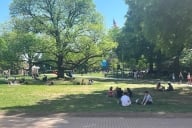You have /5 articles left.
Sign up for a free account or log in.
I think it was March, just after the shutdown, that I added my first COVID asterisk. I’d been looking forward to presenting a paper at a conference of early Americanists in June. Soon after that came another: I’d been awarded a research grant, but travel was now prohibited by my university. Then my daughter’s soccer season was canceled, followed soon after by summer camp.
Everyone I know can recite their list of asterisks, some large and monumental and others small. We have hopes now, not plans. In the scheme of things, I’ve been tremendously lucky, and the asterisks that have been piling up in my work and home life are minor.
As academics, many of us are fortunate to be able to do our work from home. But our work now takes place within a profoundly altered landscape where work/life balance is a laughable fiction and our work time is pieced together in fragments between troubleshooting a child’s e-learning tech issues, helping with math homework and cobbling together a lunch between Zoom meetings from whatever happens to be in the fridge.
For a substantial percentage of the professoriate, COVID has brought a new level of precarity to what was already an increasingly untenable profession, with tenure-line positions for the few, and poverty-level adjunct wages for many of their peers with indistinguishable CVs.
The COVID pandemic is revealing and magnifying the inequities that have long been present in the academy: faculty are losing their jobs, others are struggling to meet the demands of online teaching while caring for their own children at home, research agendas have ground to a halt.
The invisible work of academia -- the tending to students, the course prep, the work moving online -- has mushroomed, robbing many faculty of the ability to focus on the one type of work deemed most relevant to hiring, review and promotion: research and publication.
This earthquake in academia threatens to set women and minority faculty as an aggregate back decades.
How will the unequal impacts of COVID be documented and considered in reviews, promotion and applications? Universities are scrambling to adjust policies -- granting extensions to the tenure clock, easing service burdens -- but the recognition is dawning that many of these measures are stop-gap at best.
The pandemic is unprecedented, and many universities, including my home institution, Indiana University, are mobilizing and funding initiatives to address these challenges.
Soon after publishing "COVID CV," I led a team of four faculty and a computer science graduate student at IUPUI* in submitting two grant proposals for internal funding to develop an app that faculty can use to generate their own COVID CV: a graphically designed visual representation of the user’s work and home lives that can make visible the impact of the pandemic. We received close to $40,000 from the IU Office of the Vice President for Research and the IUPUI Arts and Humanities Institute to launch our project. We are on track to enter beta testing by the end of the semester.
We believe the COVID CV app can be an important resource for faculty to use in documenting the additional burdens and challenges posed by the pandemic. The COVID CV could be used for personal therapeutic purposes, but also for professional development, review and potentially applications as well.
For the COVID CV to have a larger impact on shaping discussions happening in deans’ offices across the country, we are planning to launch an exhibit website with representative COVID CVs that show the disparate impacts of the pandemic. We hope this work can help to redefine what we consider the essential work of academia by documenting the vital but often unrecognized work so many faculty and instructors contribute to their universities.
If you are interested in participating, please click here to submit your contact information or contact Rachel Wheeler at wheelerr@iupui.edu.
*Associate Professor of Psychology Jane Williams; Professor of Computer Science Rajeev Raje; Associate Professor of Visual Communication Design Aaron Ganci and computer science student Umesh Raja.




